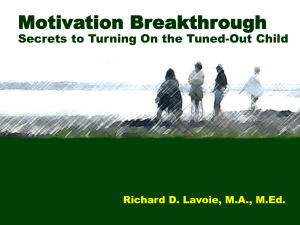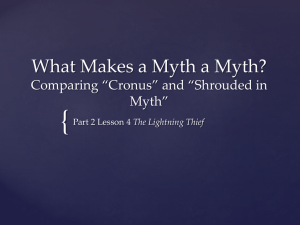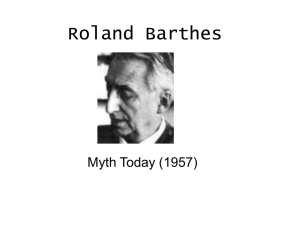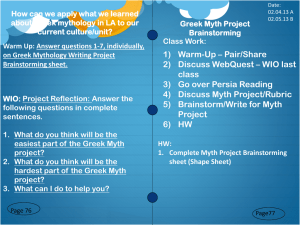Manicheaism - Mark Fullmer
advertisement
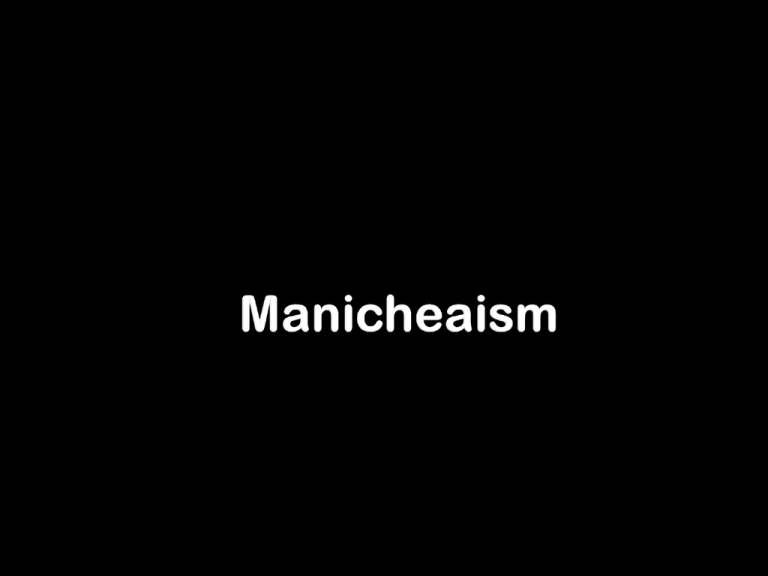
Polytheism Monotheism Animism Cosmogony Manicheaism/Manichean Zoroastrianism 1. Which creation myth states that there is another world/universe before the creation of ours and we are “born” out of this world into ours? (a) (b) (c) (d) (e) Ex nihilo Creation from chaos World Parent Emergence Earth Diver 2. In which creation myth does a god send a representative to create land and creatures from raw materials? (a) (b) (c) (d) (e) Ex nihilo Creation from chaos World Parent Emergence Earth Diver 3. Which society portrays the gods as expecting humans to worship them, and that punishment from the gods is really when they are teaching humankind a lesson about being humble? (a) (b) (c) (d) Luzon Visayas Greece None 4. Which society’s creation myth states that land was created by bits of metal or minerals, that were the bodies of the gods, which separated and fell into the sea when the gods fought? (a) (b) (c) (d) Luzon Visayas Greece None 5. Which society’s creation myth does NOT mention the gods fighting among themselves for power? (a) (b) (c) (d) Luzon Visayas Greece None 6. In the Greek creation myth, at the beginning of time what was the name of the god/goddess of all things? ____________________ 7. What is a recurrent theme, or more specifically prophecy, in Greek myth, as mentioned in the reading from last class? ____________________ 8. In your opinion, how do the different creation myths reflect the different socioeconomic or nascent political values between Filipino culture and Greek culture? ______________________________________ ______________________________________ ______________________________________ ______________________________________ 9. Did you do the reading from the “Zend Avesta”? (a) (b) (c) Yes No Partial 7 6 8 5 2 4 3 1 9 Iliad & Odyssey 700 B.C. Gilgamesh 2500 B.C. Torah 600 B.C. Aeneid 29 B.C. Zend-Avesta 600 B.C. El Cid 1200 A.D. Beowulf 900 A.D. Song of Roland 700 A.D. Song of Hiawatha 1855 A.D. Biag Ni Lam-ang 1600 A.D. Founded in the 6th century B.C. by the prophet Zoroaster in modern-day Iran. The creator is Ahura Ahura Mazda Mazda, who is ALL GOOD. Nothing evil exists in him. Angra Mainyu (or Ahriman Ahriman) is the chaotic or destructive principle. Underlying philosophy is of dualism, or Manicheaism: everything in the universe is balanced inbythe itsuniverse opposite everything is balanced by its opposite Is Zoroastrianism monotheistic, polytheistic, or animistic? Main value/belief: active participation in life through good deeds is necessary to ensure happiness and to keep chaos at bay. The first of the good lands and countries which I, Ahura Mazda, created, was the Airyana Vaêgô, by the Vanguhi Dâitya. Thereupon came Angra Mainyu, who is all death, and he countercreated the serpent in the river and Winter, a work of the Devas. 1. 2. 3. 4. 5. 6. 7. 8. The Serpent in the River & plague of Winter The Locust, which kills animals & plants Plunder and sin Ants and ant-hills The sin of unbelief Tears and wailing Pairika Knâthaiti, who clave unto Keresâspa Pride 9. Unnatural sin (for which there is no atonement) 10. The burying of the dead 11. Witchcraft 12. Utter unbelief 13. The cooking of corpses 14. Abnormal issues in women & barbarian oppression. 15. Abnormal issues in women & oppressive heat 16. Winter Ponder your own world today, in 2012. Then, in the style of Zoroastrianism and the Zend Avesta, create a list of good things created by Ahura Mazda and bad things created by Ahriman. Written submissions (electronic or paper) 12 point Times New Roman Font throughout Double spaced 1-inch margins Header should include your name, the course name, and the date at the upper right Juan Chicharron Lit 127 July 9, 2012 Contemporary Myth Documentary Myth/Folklore Title: MALL SNAKE Follows stated formatting, grammar & mechanics rules. 10% In writing/audio/video format, is stylistically professional and and structurally efficient. 20% Properly documents the source of at least 5 contemporary myths, including the name, age, hometown, and occupation of the informant, as well as a transcription or reenactment of the myth. In the analysis, provides clear background information about why the myth might exist in the community, how it might have originated, and what purpose/function it serves to the community In the analysis, evaluates the evidence presented and makes a conclusion about the likely validity of the myth. 30% 20% 20%




